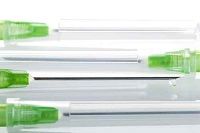Article
Needles Are Dangerously Long in Kids' Auto-Injectors, Study Finds
Author(s):
Needles are so long they could strike bone in almost half of all pediatric auto-injectors, Canadian researchers report.

Data from a new clinical investigation of epinephrine auto-injector (EAI) treatment in pediatric patients presented to the annual meeting of the American Academy of Allergy, Asthma & Immunology(AAAI) raise safety concerns about the length of needles in devices used in the United States and Canada.
Calculations by lead author Harold L. Kim and fellow researchers from Western University Schulich School of Medicine & Dentistry London, Ontario in the AAAAI’s Journal of Allergy and Clinical Immunology show this type of emergency intramuscular injection going painfully wrong for nearly half the infants in the group they studied.
“With ten pounds of compression, the mean skin-to-bone distance was 13.3 mm and the mean skin-to-muscle distance was 6.3 mm. That means a standard needle length of 12.7 mm would strike the bone in 43.1% of our patients,” Kim concluded.
Ultrasound studies of 53 children mean age 19.5 months were taken at two participating North American allergy clinics. Baseline ultrasound images of the anterolateral thigh recorded the critical skin to bone and skin to muscle measurements. Compression ultrasounds were taken using a transducer modified to simulate the force required to activate an EAI device. Both types were analyzed offline and blinded to clinical data.
Familiar as the standard of care for anaphylaxis, epi pens were originally developed as a battlefield antidote to nerve gas. In calling for pediatric EAI specifications for infants and toddlers the study authors maintain there is no substitute for the proven, life-saving benefit of immediate access to epinephrine the epi pen is known for. “Even with our findings, the epinephrine autoinjectors should be used when required. I often educate parents with some simple instructions on how to avoid needle penetration that is too deep. For example, squeezing the thigh muscle to prevent muscle compression while injecting the autoinjector would likely work for most children,” Kim pointed out.





